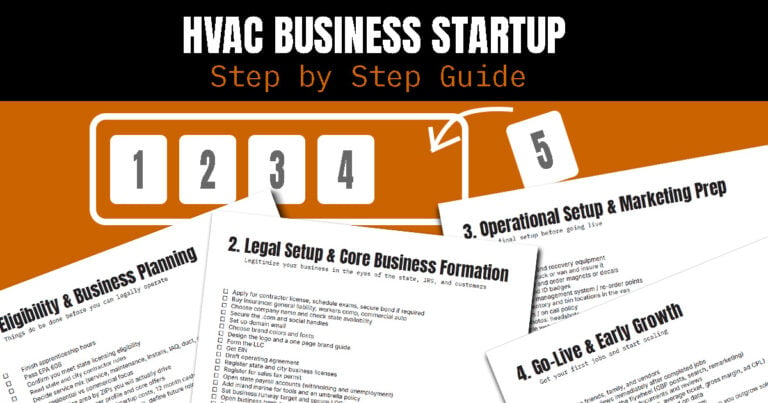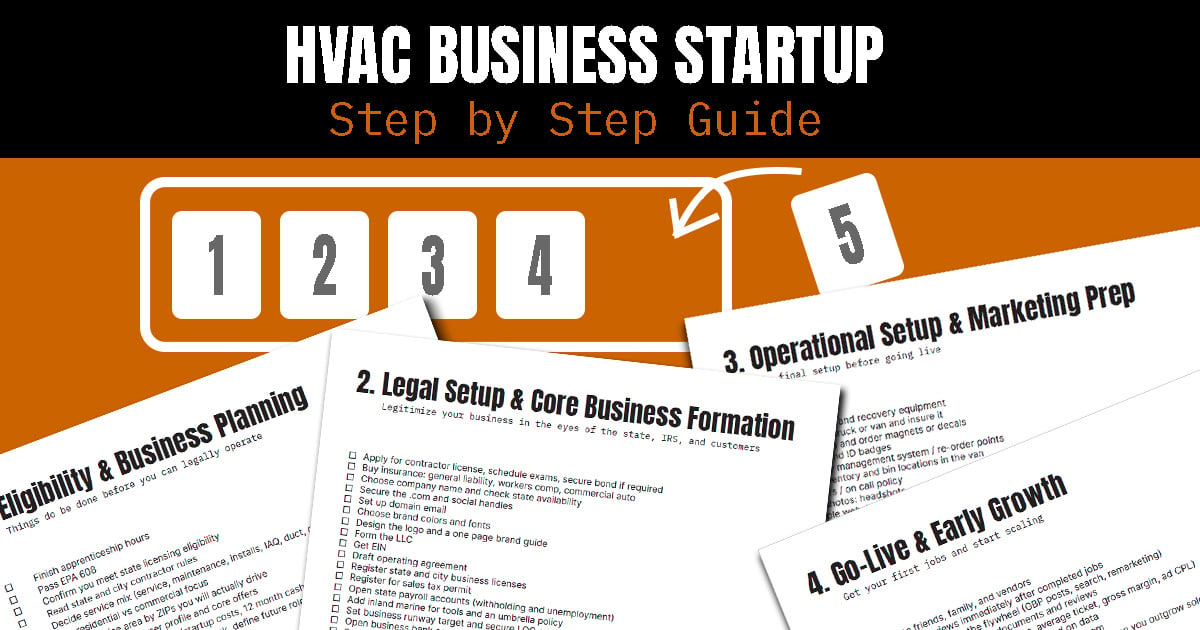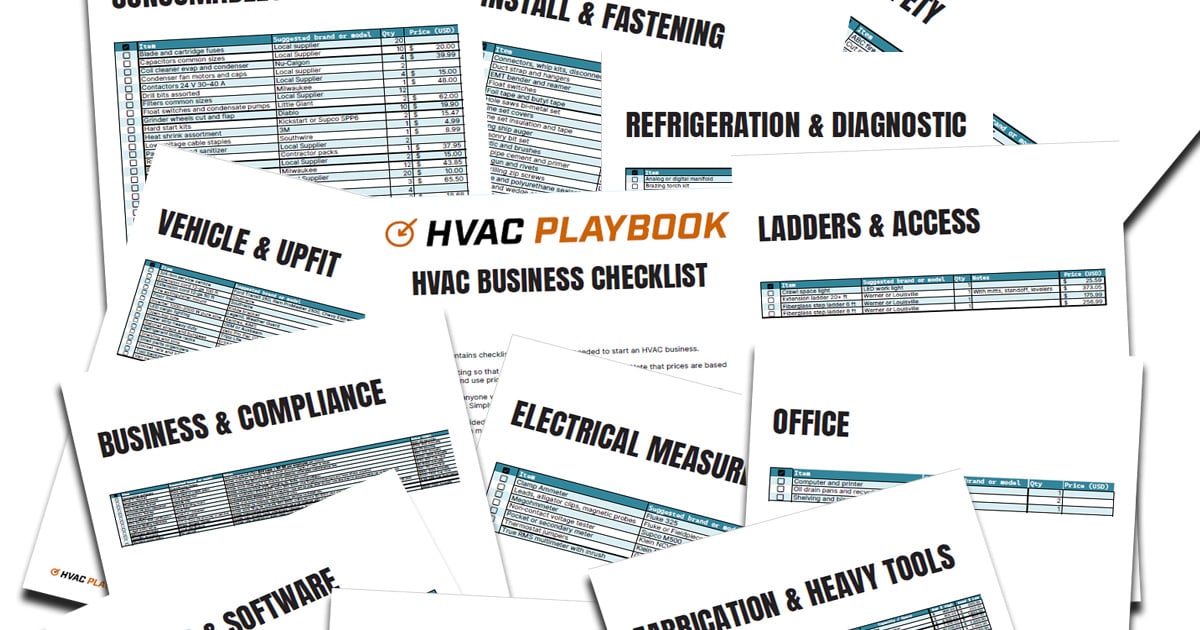This is the most complete HVAC Business Startup Checklist on the internet. If you’re serious about starting a business, the step-by-step instructions on this page will save you time, money, and confusion.
If you’re still in the discovery phase, redirect to our “how to start an HVAC business” guide. That guide was created as a birds-eye overview of the process, while this guide is written for those who are actively engaged in the startup process.
I encourage all of you to download the HVAC Business Startup Checklist below. It’s a free printable PDF of everything you need to to in chronological order. This guide expands on the steps in the checklist.
Table of Contents
Eligibility & Business Planning
Before you get to “doing”, there is some critical thinking and planning that needs to be done. There are 11 tasks in this section. Complete them in order.
Verify Contractor Licensing Eligibility
The first tasks are necessary for eligibility. You can’t run an HVAC business without your EPA 608 license or understanding the contractor rules in your jurisdiction.
- Finish apprenticeship hours (if required in your state)
- Pass EPA 608
- Confirm you meet state licensing eligibility
- Read state and city contractor rules
Decide On Your Core Business Focus
The next few tasks are focused around thinking about your business. Take this seriously and think deeply about these things. You will document your decisions in your business plan. Decisions about you service area and service mix can impact licenses and loans that will be required.
- Decide service mix (service, maintenance, installs, IAQ, duct, controls)
- Pick residential vs commercial focus
- Define service area by ZIPs you will actually drive
- Define target customer profile and core offers
Create A Business Plan & Organization Chart
A business plan is more than just a requirement to get a loan. Its your chance to catch your blind spots and get some clarity. As you create your business plan, you will also need to do some financial forecasting.
- Build a lean business plan (startup costs, 12 month cash flow, breakeven, funding, exit plan)
- Org chart (future): Even as one truck, define future roles
Save A Nest Egg
Most businesses will lose money for at least a year. Be prepared for this and save a nest egg before moving on to the next section. Failure to do this will increase your chances of failing exponentially.
If you don’t have the discipline to save, you don’t have the discipline to run a successful HVAC business. Prove you have what it takes by saving enough to cover at least 6 months of expenses.
- Set personal runway target and save it
Legal Setup & Core Business Formation
This is where things start to feel real. The majority of the hard work will be done in this phase. You have 44 tasks to complete and I would advise doing them in the order I present them.
Become A Licensed Contractor
Every state has it’s own contractor license requirements. If you did the planning from the last phase, you will already be aware of what needs to be done. Now is the time to take action.
- Apply for contractor license, schedule exams, secure bond if required
- Buy insurance: general liability, workers comp, commercial auto
Choose A Company Name & Logo
When coming up with a company name, make sure to check availability. Search the internet as well as all social platforms to make sure the name is available.
- Choose company name and check state availability
- Secure the .com and social handles
- Set up domain email
- Choose brand colors and fonts
- Design the logo and a one page brand guide
Legally Form The Business
Completing these steps officially creates the business. Most of this will be done over the internet. Make sure you register to do business in every city you plan to service.
- Form the LLC
- Get EIN
- Draft operating agreement
- Register state and city business licenses
- Register for sales tax permit
- Open state payroll accounts (withholding and unemployment)
Make Your Business Financially Independent
Do not use your nest egg to fund your startup. If you want to ease into the business, you can eliminate the need for large loans by starting your business as a side job until you are profitable.
- Add inland marine for tools and an umbrella policy
- Set business runway target and secure LOC or equipment financing if needed
- Open business bank account
- Set up accounting software and chart of accounts
- Hire a CPA and load a tax calendar
Get Ready To Collect Money
Take care when calculating your labor and overhead. A mistake here can hurt profitability for a long time. When choosing between flat rate or T&M, I highly suggest going flat rate.
- Choose pricing model (flat rate or time and material)
- Calculate burdened labor rate and overhead
- Set parts and equipment markup rules and trip fees
- Choose payment processor, ACH, surcharge policy
- Set up consumer financing provider
Choose Your Equipment Brands & Suppliers
We’ve all got preferences of equipment, but in the beginning you might need to settle. Most suppliers are going to stick you with an open brand until you prove yourself and your ability to move product. Don’t worry about it. Every large HVAC company started out by pushing the same equipment until they became stable.
- Choose equipment brands and IAQ product lines
- Apply for distributor and supplier accounts
- Open trade credit lines
Draft The Documents That Guide Company Policy
Clarity protects you customers and you. Without clearly defined policies, your ability to enforce late fees and warranty limits goes out the window.
Purchase a tablet and get some basic estimating software. You don’t have to go straight to the big players like Service Titan if you are a one man shop. Something like Joist will do just fine.
- Define install warranties, labor warranties, and callback policy
- Create contracts: service agreement, install contract, change order, lien notices
- Create Collections policy: Terms on deposits, progress payments, final payment deadlines, late fees.
- Build estimate, invoice, and proposal templates
- Purchase tablet (paper invoices are no longer the norm)
- Define sales process / follow-up schedule
Protect Yourself From Fines
OSHA is going to check up on you. Be prepared so you don’t get fined. It’s a matter of if, not when.
- Write safety plan and PPE list (OSHA basics) OSHA requires: hazard communication, lockout/tagout, fall protection, respirator fit testing, heat illness prevention (if relevant to your state).
- Create refrigerant handling SOPs and logs (608 recordkeeping)
- Define permitting process with each AHJ you will use
Create A Way To Manage Customer Communication
Get a CRM right off the bat. The worst time to try to organize all your customers is when you have enough to require organizing. Come up with a system and stick to it from day 1. You’ll thank me later.
- Pick CRM and dispatch software
- Pick flat rate book or estimating system
- Set up phone system and call tracking
Protect Your Digital Assets
I know this step sounds stupid, but I have personally witnessed to headache and stress associated with disappearing information, and I can tell you it’s not worth it. You can get basic could storage with enough capacity for your first year or two at no cost.
- Set up cloud storage, and backups
- Enforce MFA and a password manager
HR & Office Requirements
Even if you are starting out as a 1 man operation, you need to do these steps if you have any ambition of growing. Don’t wait until you need the help to figure this stuff out. By the time you need to hire, you’ll already have enough other things to worry about.
- Create a forms and SOP repository for field and office
- Decide on Background checks / drug screening policy (common in residential HVAC)
- HR compliance basics (W-4, I-9, harassment policy, workers’ rights posters)
- Employee handbook outline before your first hire (not after you “outgrow solo”)
Operational Setup & Marketing Prep
Just before going live to the public, you need to get branding, advertising, starting inventory taken care of.
There are 19 things to do in this section. This is the final stretch. After these things you will officially start serving customers. Don’t rush to the finish line. Take the time to address all of these steps and you’ll be setting yourself up for success.
Buy The Essentials
You might already have some of the required tools. Don’t forget the things that your employer would usually provide. Our HVAC Business Startup Cost Guide can help ensure you don’t forget anything.
- Buy essential tools and recovery equipment
- Acquire a reliable truck or van and insure it
- Design truck wrap and order magnets or decals
- Order uniforms and ID badges
Stock Initial Inventory
You’re inventory management system can be as simple as a printed spreadsheet or even a paper with re-order points that you check against once a week. Don’t over-complicate this step, but make sure you take the time to at least define the inventory you need and when it’s time to re-stock.
- Create inventory management system / re-order points
- Build starter inventory and bin locations in the van
Website & Listing Prep
Your hours and pricing can be decided and built based on experience with other companies, or better yet, by taking into account your burden labor rate and overhead.
When it comes to photos, use a camera if you can. If you only have a phone available, make sure you get photos in good lighting, such as an hour after sunrise or an hour before sunset. Your photos need to be the highest quality you are capable of. They’ll be the public’s first impression of your company.
- Decide on hours / on call policy
- Shoot brand photos: headshots, van, before and afters
- Create service agreement terms, pricing, etc
Build Your Online Presence
The steps here might seem intimidating, but I promise you, they are easier than they seem. Check out our HVAC marketing guide if you need step by step instructions.
- Launch a simple website with clear CTAs and service area pages
- Create and verify Google Business Profile
- Claim core citations (Apple Maps, Bing, Yelp, Angi, Thumbtack)
Set Up Systems To Win And Keep Customers
Automate you review collection and communication from the beginning. Can you handle manually texting a few customers in the beginning? Technically, yes. But you are going to have way bigger things to worry about. Set up the automation now and then forget about them.
- Build a review funnel with scripts and automations
- Set up analytics, Search Console, and conversion tracking
- Create offers and a seasonal promo calendar
- Create referral Program
- Open Google Ads and Meta Business Manager accounts
- Build a basic email platform with a welcome series
Make Final Price Adjustments
Do some digging on-line. Call some of your competitors. Do whatever you need to do get a feel for the market pricing and make required adjustments before going live.
- Price check against your market and adjust if needed
Go-Live & Early Growth
This is it. It’s time to start serving customers. Start by offering your services to people you know. Don’t do the work for free. Give them quality service and treat them as a customer. Make sure you get reviews from them for your google business profile.
After that, its time to start some light advertising to keep the pipeline full.
These are the final 8 steps to successfully starting and HVAC business.
Soft Launch
- Soft launch to friends, family, and vendors
- Ask for first five reviews immediately after completed jobs
Fill The Pipeline
- Turn on light ads to start the flywheel (GBP posts, search, remarketing)
- Apply for LSAs when you have documents and reviews
Make Adjustments To Stay Profitable
- Track KPIs weekly (leads, booked jobs, average ticket, gross margin, ad CPL)
- Job cost every install and tune pricing based on data
Set Yourself Up For Growth
- Document install and service SOPs and enforce them
- Build a hiring plan, handbook, onboarding checklists when you outgrow solo
Conclusion
Starting an HVAC business is a lot of work. If you followed every step in this guide, you’re already far ahead of most of your competition.
Now that you have a business, you’re going to need to learn how to run it. You’ll learn quickly that knowing HVAC and knowing business are two completely different things. We’ve got you covered.
Make sure to sign up to our newsletter to give yourself the edge over your competition and keep up to date on the business secrets used by the big guys.
If you used this guide, or the attached checklist, to help start your business, let me know. I’d love to hear from you. Send an email to jacob@hvacplaybook.com



